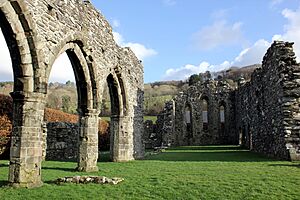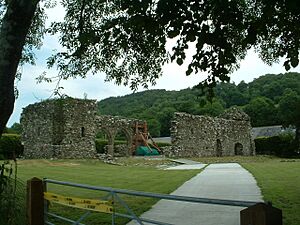Cymer Abbey facts for kids
Cymer Abbey (which is Abaty Cymer in Welsh) is an old, ruined abbey in north-west Wales. It's close to the village of Llanelltyd, just north of Dolgellau, in Gwynedd. An abbey is a special place where monks or nuns used to live and pray. Cymer Abbey was home to Cistercian monks.
Contents
The Story of Cymer Abbey
How Cymer Abbey Started
Cymer Abbey was built a long, long time ago in 1189. It was started by two important Welsh leaders: Maredudd ap Cynan and his brother, Gruffudd ap Cynan. They wanted to create a place for Cistercian monks to live and worship. The abbey was dedicated to the Virgin Mary. It was like a "sister" abbey to another one called Abbeycwmhir in Powys.
What Cymer Abbey Looked Like
The buildings of Cymer Abbey were quite simple. The church and its west tower were plain but strong. Their walls still stand quite tall today. The church had a main area called a nave and side aisles. It didn't have the usual large side wings (transepts) that many abbeys had. The main parts of the church were built from local stone. You can still see the foundations of other buildings where the monks lived and worked. The abbot's house, where the head monk lived, is still there. It has been changed into a farmhouse over the years.
Life at the Abbey
Like other Cistercian abbeys in Wales, the monks at Cymer Abbey were good at farming. They raised sheep and bred horses. They even supplied horses to Llywelyn ap Iorwerth, also known as Llywelyn the Great. In 1209, Llywelyn gave the abbey rights to mine for minerals.
Why the Abbey Wasn't Rich
Even with mining rights, Cymer Abbey wasn't very wealthy. It didn't have much land for growing crops. Also, its fishing rights were limited. In 1291, the abbey's yearly income was only about £28. This wasn't a lot of money back then. The wars led by Edward I of England in the late 1200s probably made things worse. The abbey was even used by Prince Llywelyn ap Gruffudd's soldiers in 1275 and 1279. In 1283, King Edward I took over the abbey. A year later, he paid the abbey £80 for the damage caused by the wars.
The cooler weather in the 1300s also affected the abbey's lands. Most of their land was in the mountains, which made farming harder. Because they weren't rich, they couldn't build a tall central tower like many other Cistercian abbeys.
The End of the Abbey
By 1388, there were only about five monks living at Cymer Abbey. It seems their religious life wasn't as strict as it used to be. In 1535, the abbey's yearly income was just over £51.
In the 1530s, King Henry VIII of England decided to close down many monasteries and abbeys. This was called the Dissolution. Cymer Abbey was dissolved in 1537 because it was small and not very important.
However, the abbey did have a beautiful silver-gold cup and plate from the 1200s. These were used during church services. They must have been hidden when the abbey closed. They were found in 1898 under a stone. Now, you can see them at the National Museum of Wales in Cardiff.
The Abbey's Location
Cymer Abbey is located in a special spot. A small stream runs south of the old cloister (a covered walkway). The abbey is also on the banks of the River Mawddach. It's just above where the River Wnion joins the Mawddach. Because it's where two rivers meet, the abbey was sometimes called "Kymer deu dyfyr." This means "the meeting of the waters." It was also built at the lowest place where people could cross the River Mawddach.
Today, Cymer Abbey is looked after by Cadw, which protects Wales' historic sites. Like many other old monasteries, parts of the abbey were taken apart after it closed. The stones were used to build other things. The ruins are next to a working farm and are open for people to visit most days of the year.
Images for kids





